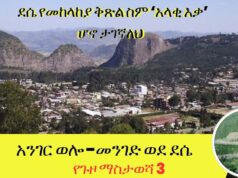[ Teklemichael Abebe Sahlemariam is an Ethiopian national and a Toronto-based lawyer practicing immigration, Family and criminal defence law. Other anonymous individuals also contributed to this article. ]
As someone who was born and grew up in Ethiopia, the author of this article is concerned about the conflict that is taking place there at this very moment. In particular, the author sympathizes with the plight of the innocent civilians who find themselves caught between the two warring sides and believe that we must do everything within our power to raise their plight and concerns to the attention of the international community. Calling upon Canada to assist in deescalating the situation is a response with which the author concurs, as he made clear in his interview with the CBC World Report that aired on Saturday, November 14, 2020.
At the same time, while speaking out against the senselessness of the conflict, one must also be careful not to echo only one side’s point of view. Genuine peace and calm can only be achieved by addressing the root cause of the conflict and by holding all sides accountable.
In his article for CBC News, a Canadian immigration and human rights lawyer Bashir Khan squarely put the blame on the federal government of Ethiopia by stating that it triggered the conflict earlier this month by ordering its troops to attack the remote northern region of Tigray. While it is correct to say that Prime Minister Abiy Ahmed sent federal troops to Tigray to quell an armed regional force, it should be pointed out that, prior to that, the Tigray People’s Liberation Front (TPLF) arrested and brutally murdered members of the Ethiopian military’s North Command. Moreover, the TPLF even admitted to the media that it had taken what it called “anticipatory self-defence” or pre-emptive measures by attacking the Ethiopian army. Should one not mention that important piece of the puzzle? And what about the TPLF’s indiscriminate rocket attack on the two Ethiopian cities of Gondar and Bahir Dar, and on Asmara, the capital of Eritrea? Amnesty international also reported that atrocities committed at a place called Mai-Cadra on November 9, which, based on preliminary accounts, were committed by the TPLF.
As the international community has recognized, the conflict in Tigray Region started after the region’s special force and members of the national army attacked several local military garrisons of the Ethiopian National Defence Forces (ENDF) on the evening of November 3/early morning November 4, 2020. The ENDF was ordered to defend the attack and to apprehend and bring to justice the Tigrayan leaders who were behind the attack.
Root cause of conflict
Ethiopia is a federation of 9 (10 with the new State of Sidama) states and 2 city administrations. Its northernmost Tigray Region is governed by the TPLF and contains only about 6% of the Ethiopian population. However, by exploiting the country’s ethnic fault lines, the TPLF was the dominant political, economic and military force in the country for 27 years and controlled at least 25 % of state structures until April 2018 when the new Prime Minister, Abiy Ahmed, came to power. Arguably, it was the TPLF’s loss and subsequent desire to regain its unfair and disproportionate influence that ignited the current conflict.
Prime Minister Abiy was gradually beginning to redistribute state resources, thus providing more opportunities to all Ethiopians, which resulted in a seismic change in the TPLF’s hitherto enjoyed privileges. The TPLF eventually withdrew its support from the coalition with Abiy and returned to its base in Tigray Region and continued rebuilding its military forces. Over the last two years the TPLF managed to build the largest militia and special forces in the country, estimated at approximately 250,000 personnel, and has held several military parades to show off its strength. If such numbers are indeed more or less accurate, why would a regional government require so many troops? Imagine how Canada’s federal government would respond if Ontario or Quebec or Manitoba deployed 250,000 troops to attack the Canadian army.
The Abiy administration has also accused the TPLF of supporting various insurgent groups in order to destabilize the country, the theory being, the more unstable the country, the more easily the TPLF can reassert itself as the force best suited to run the country. Moreover, the TPLF has called the Abiy administration an illegitimate government, particularly after the national elections scheduled for August 2020 were postponed due to the COVID-19 pandemic. The TPLF conducted a campaign of fear by saying that the Ethiopian government would lose legitimacy as of October 5, 2020 when a new government would have been sworn in according to the Ethiopian constitution, were it not for the pandemic.
There were various attempts to ease the tensions between the federal government and TPLF, including mediation efforts by the country’s elders. For example, in June 2020 Ethiopian elders travelled to Mekelle, the capital city of Tigray, and appealed to the regional administration for peace. However, none of these efforts succeeded. The political division became so extreme that it was only a matter of time before the TPLF and the federal government engaged in a military confrontation.
On November 3, 2020, the TPLF started the conflict by attacking the ENDF garrisons in Tigray, killing members of the national army and commandeering significant military hardware. These attacks have been corroborated by the US Department of State and later acknowledged by the TPLF leadership.
Why the TPLF attacked the ENDF
The TPLF leadership stated that it launched the attack to neutralize the ENDF by controlling its military arsenals. The ENDF has had a significant presence in Tigray for the last 20 years as the region shares the country’s border with Eritrea, which fought a deadly war with Ethiopia from 1998 to 2000. The TPLF explained this attack as a pre-emptive strike in self-defence. However, as stated by Mr. Tibor Nagy, Assistant Secretary for the US Bureau of African Affairs, the most likely objective of the TPLF operation was to oust Abiy from power and regain control of the federal government.
However, the TPLF overestimated its military might and underestimated the resolve of Ethiopians to never allow them again to take control of power in Addis Ababa. Moreover, the TPLF actions against the ENDF have united the country behind Prime Minister Abiy. Even such fierce opponents of the Abiy administration as the party of political prisoner Eskinder Nega, have fully supported Abiy’s response to the TPLF attacks. Again, as confirmed by the US Deputy Assistant State Secretary for Africa, Tibor Nagy, the TPLF tactic “has really stoked Ethiopian nationalism” and brought the nation together in support of Abiy.
State of conflict and Misinformation about conflict
In the last two weeks, the ENDF, with the support of the Amhara state police and militia, have encircled the TPLF forces at Mekelle, the capital of Tigray. The federal government claims that the conflict should be finalized in a few days. However, the TPLF has recently threatened to engage in guerilla warfare if they lose the current conflict. This is an ominous and significant threat to Ethiopia’s national security as Tigray’s mountainous landscape has made it difficult in the past for any government to fully control the region.
Thus, there has been considerable confusion in the international community regarding the nature and cause of the conflict. Bashir’s article’s has only added to this confusion. It is incorrect to see this conflict as a civil war, an ethnic conflict or a struggle for self-determination. Commentators should therefore be cautious when writing about issues about which they apparently have limited knowledge.
The ENDF’s use of force against the TPLF is law enforcement on a large scale. The TPLF leadership unlawfully disobeyed federal government institutions. For example, for two years now the TPLF has refused to hand over the former Chief Intelligence Officer, Getachew Assefa, who was allegedly responsible for heinous human rights violations in the country. The regional government also violated the federal constitution by forming its own electoral commission and holding elections. Such actions were in direct violation of Ethiopia’s constitution. Ethiopia’s House of Federation (upper house), which, with exclusive jurisdiction over constitutional interpretation, had decided that all elections would be postponed until COVID-19 was under control. Instead, the TPLF leadership ordered the killing of Ethiopian soldiers and the looting of ENDF arsenals. Prime Minister Abiy was therefore attempting to apply the rule of law by bringing the perpetrators of these crimes to justice.
This by no means is to say that the Abiy administration is a democratic regime that respects the rule of law or that is has a good human rights record. To the contrary, the Abiy administration has been losing its democratic character, if it had any, by targeting its political opponents, by restricting freedom of assembly and of the press, and by failing to protect innocent civilians from deadly hate crimes. However, these shortcomings are no excuse for a failure to understand why Abiy was compelled to take military action against the TPLF forces. The TPLF brought this response upon itself. There were two more areas of major misinformation in Bahir Kahn’s CBC opinion column.
Tigray people not the target of conflict
The people of Tigray have suffered under the TPLF regime as much as any other people in Ethiopia. They have been living under the TPLF’s extensive security structures and strict surveillance and have had no independent press for the last three decades. The TPLF has fully controlled the flow of information within Tigray and has denied public access to unsanctioned information. Since 1991 no opposition party in Tigray could freely run an election campaign. Only by such repression did the TPLF win 98.5% of the votes in the regional election and take all but one of the 190 seats in the regional legislature.
With no mandate acquired in a free and fair election, the TPLF cannot speak on behalf of the people of Tigray. The TPLF’s claim that Abiy is targeting the people of Tigray is completely lacking in credibility. As it stands now, Tigray is part of the federal republic. Any lawyer who has represented Ethiopian refugees over the past ten years would know that the TPLF has committed the most heinous of crimes and human rights violations in the country. TPLF is not a party than can be trusted with the wellbeing of the people of Tigray, and it is against such a party that the Ethiopian federal government is taking action. Thus, it is factually wrong and ethically irresponsible to characterize the conflict as being one against the people of Tigray.
That said, a truce and lasting peace are aims for which all should strive. However, that cannot be achieved by stating half-truths. While people perish, it is important that we should remain magnanimous, objective and, above all, truthful. Moreover, there are credible reports of the ethnic profiling of Tigrayans in Addis Ababa by officials of the Abiy administration. This is unacceptable, must be stopped, and those responsible brought to justice. The government of Ethiopia should end information blackout. It has also to open safe corridor for humanitarian aid. Last but not least, the government of Ethiopia should always leave room for dialogue and mediation.
Conflict not about right to secession

























